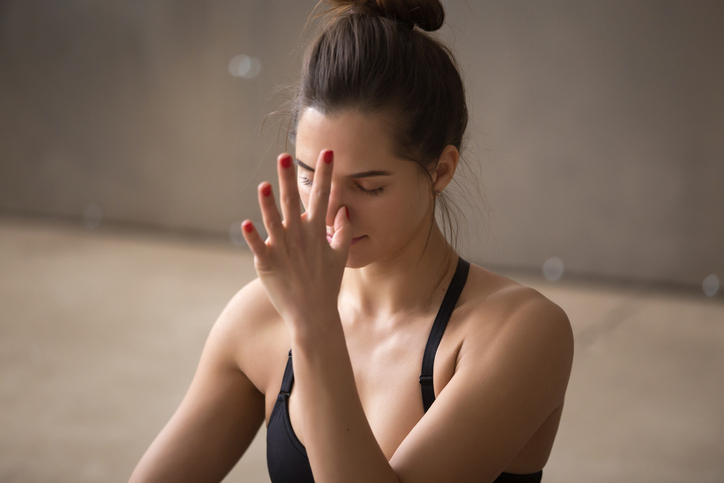Yoga pranayama: like doing the alternating breathing exercise?
Caution : You must consult your doctor for your health. This page presents only a personal and alternative point of view which should not be considered as an attempt to prescribe medicine.
Breathing well is the foundation of physical and mental well-being.
To optimize the benefits of such an activity, the ideal is to have a breathing technique that will allow the body and the mind to be in symbiosis in order to promote good concentration.
Yoga pranayama is a breathing method that follows this logic.

It contains several respiratory exercises among which the altered breathing, also called Nadi shoddhana, which has unsuspected therapeutic virtues.
Yoga pranayama: what is it?
First of all, pranayama is one of the eight branches or pillars of yoga.
As a reminder, yoga is a discipline from India.
It ensures the balance and the union of all aspects of a being (mental, spiritual, physical).
This is only made possible by a series of physical exercises and breathing practices.
Pranayama is considered the discipline of breath control.
It cannot be otherwise, because etymologically, this word can be broken down into two parts: prana and ayama.
The term prana refers to the notion of breath.
Here it is not about the physical aspect of the breath, but rather the life energy that the breath represents for the body and the mind.
On the other side, ayama means retention, control or mastery.
We can therefore define pranayama as an activity promoting the retention of breath or the mastery of the breath.
There are therefore several techniques of pranayama which allow to control this movement of vital energy.
And alternating breathing is one of the most popular exercises to balance your vital energy.
How to practice alternate breathing?
To practice alternate breathing or Nadi shoddhana, it is imperative to adopt a position conducive to breathing practices.
In this case, you will not have the expected result even if all the other conditions have been met.
To do this, it is advisable to sit in a cross-legged or half-lotus position with the spine straight.
Whether on a cushion or a simple rug, the ideal is to choose an object on which you will be comfortable.
Of course, the legs are crossed and the shoulders relaxed.
Next, you need to place your index finger and middle finger on your forehead between your two eyes.
Use the hand of the right arm to do the exercise.
Also close your eyes during the exercise and focus on your breathing.
After that, you press lightly on the right nostril with your thumb in order to block the passage of air.
You always first breathe out.
Then, you inhale deeply, still through the left nostril which is open.
When you feel your lungs completely filled, you plug the right nostril with your ring finger and then you can breathe out through the left nostril.
At the end of the exhalation, inhale again through the same right nostril, keeping the left nostril closed.
At the end of your full inhalation, you will stop the right nostril with your thumb to exhale through the left nostril.
And you continue the same way for a few minutes.
The end of the exercise will always be done by exhaling through the left nostril, the one where we started to exhale.
Additionally, to make this breathing exercise more interesting, you can hold your breath for a few seconds before inhaling.
It is a retention of breath (suspension of breathing) after exhalation, also called: bahir kumbhaka.
At the end of the exercise, you will notice that some parts of the body that used to be numb are no longer.
You will naturally be more relaxed.
For beginners, they can enroll in a Yoga class to benefit from professional follow-up with an experienced Yoga teacher.
In addition, do not forget that it takes training to control your breath and reap the benefits.
There is therefore no point in getting discouraged on the first try or trying to skip ahead.
It is best to start with 5 minutes of practice per day and add 5 minutes every month.
After 5 months, you will be able to do 30 minutes of alternate breathing per day, which will seriously reduce your stress level while increasing your energy level.
What are the benefits of Nadi shoddhana?
Still called Nadi Shuddhi, alternate breathing is one of the exercises that should be practiced by anyone wishing to have perfect health.
In fact, it helps to fight against stress and all distressing situations.
It is obvious that in these anxiety-provoking situations, breathing becomes irregular, short and unpleasant.
Some people even end up with a blocked diaphragm if the stress becomes intense or chronic.
By acting on breathing, we manage to evacuate stress and calm the nervous system.
This breathing technique is also recommended for those who have trouble sleeping.
It is enough to practice it at the end of the day to benefit from an optimal and restful sleep.
Indeed, it allows you to clear your head and get rid of all negative thoughts.
In addition, the body is relaxed, which allows you to quickly fall into the arms of Morpheus.
It is also a great option to start your day with incredible energy while remaining Zen.
In this case, you must imperatively practice before breakfast in order not to disturb your digestion.
In addition, it allows to oxygenate the two hemispheres of the brain because the alternating breathing has the effect of balancing the two branches of the nervous system, called Ida and Pingala in Yoga.
This rebalancing of the nervous system will have innumerable beneficial effects:
- it promotes better blood circulation
- it reduces blood pressure
- it relieves the bronchial tubes of people with asthma
- it decreases the production of cortisol and adrenaline, the stress hormones
etc.
Clearly, this alternating breathing is a perfect yogic exercise to reduce your stress in order to better control your energy at any time of the day.
❤ The ultimate guide to breathing
Intermittent Breathing : Discover the method to quickly relieve your anxiety and chronic fatigue (positive effects from the first use).Read also :
Previous article : Full yogic breathing on 3 levels: benefits and dangers?
Next article : Breathing draft: causes, symptoms and solutions?

